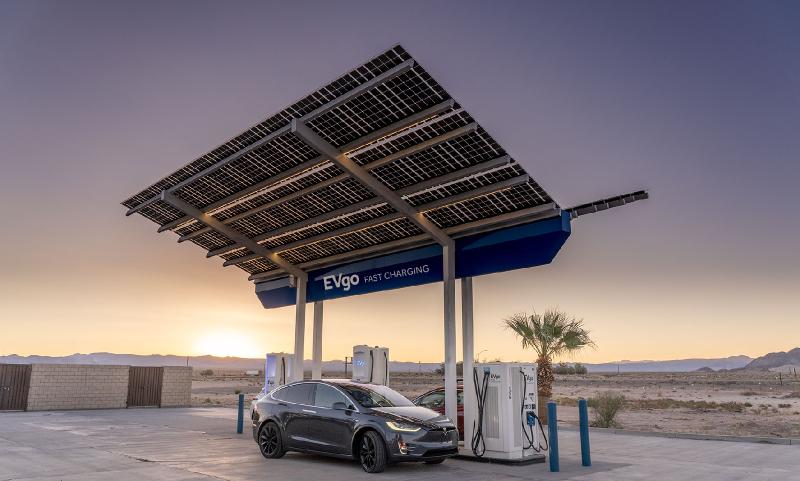Think The Solar Canopy Is Powering EV Fast Chargers? Think Again.
By: Aaron Gordon (Vice)


You'd think with the emphasis on science literacy that people would understand the simple requirements for EV charging stations. There is a reason that carbon emissions from transportation are as large as carbon emissions for electricity generation. Switching to electric vehicles means we would need to double capacity to generate electricity.
The public is being provided clues. After all, one of Ford's selling points for their planned EV F-150 truck is that it can power a house.
As the article points out, a single 350 kilowatt fast charger requires 1,094 solar panels covering 20,000 square feet. Rooftop solar panels on a Walmart Supercenter (with a floorspace of 180,000 square feet) could power 9 fast charging stations. Those 9 fast charging stations could provide power for 360 EVs a day (averaging four charges per hour over 10 hours). Providing power for 10,000 EVs would require 28 Walmart Supercenters (5 million square feet of solar panels).
According to the current best estimate, there are 280 million cars in the United States. Assuming half of those cars are in daily use (140 million) then switching to EVs would require 70 billion square feet of solar panels to fast charge those EVs. That would be 390,000 Walmart Supercenters. At present there are 3,600 Walmart Supercenters in the United States.
All of this is mathematics; not pessimism. Blue sky may be a necessary component for converting to EVs but the conversion is going to require much, much more than blue sky.

Recently, a user on r/ElectricVehicles posted photos of an Electrify America fast charging station with a roof over the chargers made of solar panels, called a solar canopy. The comments were overwhelmingly enthusiastic, wondering why all EV chargers don't have solar canopies that both shield vehicles from the elements and provide electricity to power the chargers. A true win-win situation, right?
Yes, solar canopies are good. They create some renewable energy where there was none before and they make charging stations more pleasant to use. But it is also important to recognize they do not, by themselves, make charging stations green, or come even remotely close. If we don't rapidly educate electric vehicle owners on how much electricity fast chargers use and how it compares to other electricity uses they're more familiar with, we risk solar canopies being little more than green energy theater.
One of the greatest blind spots I come across regarding EVs is most people do not know the sheer amount of electricity required to power just one direct current fast charger (DCFC), the kind that most people imagine will replace gas pumps for the quick fill-up while on long drives. This is a byproduct of most people not having any real reason to understand electric units of measurement. But if more people did understand them, they might intuitively grasp that not only is a solar canopy insignificant to the power demands of a fast charging station, but that reliance on fast charging will make a rapid conversion to renewable energy that much harder.
Most DCFCs these days can charge at speeds of either 150 kilowatts or 350 kilowatts. According to a study by fast charging company EVGo, under standard use, a bank of four chargers requires as much power as that needed to power 100 and 230 homes, respectively. In other words, just four of these chargers have the energy demand of an entire housing subdivision. Compare that to a typical solar panel, which under ideal conditions can generate about 320 watts, according to solar company Sunrun. In order to power a single 150 kilowatt fast charger, a company like Electrify America would need to install 469 solar panels. A single 350 kilowatt charger would require 1,094 solar panels under ideal conditions covering about 20,000 square feet. And that's just for one charger. Most charging stations with solar canopies have a dozen or so fast chargers requiring several megawatts of electricity when in use. Solar company Oya says a 5 megawatt solar farm requires some 30 to 40 acres.
I asked both Electrify America and EVgo, the two largest US fast charging companies, about their approaches to solar canopies over charging stations. And they each have different strategies.
Sourav Das, a spokesperson for EVGo, told me most EVgo stations don't have solar canopies because of this meager electricity draw compared to the station needs.
"Most of EVgo's stations do not have solar canopies or renewable energy installations on site," Das said. "In fact, it would take acres of solar and wind to power our fast-charging stations (especially our new 350 kW stations), which would be difficult in the retail parking lots and urban centers where we install chargers."
Instead of trying to make the station sites themselves greener, EVgo purchases renewable energy certificates, which it claims are "different than buying offsets of carbon because we can actually match the kWh used with the kWh we purchase, which provides financing for renewable energy projects such as wind and solar." Like carbon offset markets, these projects require third party verification by self-certifying firms. Still, Das insisted "By purchasing RECs, we have a much bigger impact than installing distributed energy on site in each parking lot."
Which is exactly what EVgo's biggest competitor, Electrify America, is doing. Spokesperson Mike Moran also acknowledged that "the solar power alone will not provide the necessary energy to power these powerful chargers" but said EA is more bullish on installing solar canopies than EVgo and combining them with battery energy storage systems (BESS), which stores energy when energy is cheaper and releases it when energy is more expensive. This is both better for the environment (cheaper energy typically coincides with higher rates of wind and solar energy) and saves EA money. But it is expensive to install and still relies on the energy mix of the grid from which it draws. Moran said EA has BESS at more than 140 DCFC stations.
While BESS would help make solar canopies slightly more useful in instances where, say, the chargers sit unused during long, bright, sunny days for long periods and then someone shows up to charge at night, it doesn't change the fundamental math that a solar array of even 100 panels would, under ideal conditions, need to charge the battery for 10 hours to get one hour's worth of electricity out of a 350 kilowatt charger. These are rounding errors, and while the solar canopy may look nice and provide some decent shade, it is not helping that fast charger be any cleaner.
Again, none of this is to say solar canopies are bad. They are a net positive, all things considered, because we need all the solar we can possibly get if we want green energy any time soon. But the relationship between EVs and that green energy is more complicated than is often presented. As a recent study argues, more than half of the emission-reduction impact from fewer gas-powered vehicles will be offset by increased emissions from the electricity sector "without significant and concurrent changes to the electricity sector far more substantial than those over the last decade." It's vitally important we not mistake those solar canopies as anything like a closed, self-sustaining system, or else the promise of EVs to drastically reduce emissions will remain just that.





Anyone can run the numbers; the math isn't difficult. Yes, it may be technically possible to convert to EVs. But doing so will require much, much more than blue sky promises.
I think I'll stick to the old gasoline powered internal combustion engine for the time being!
Only if it gets warp speed.
Of course!
Look, Nerm. All we have to do is take our gas engines out of our old cars, adapt them to run generators to power fast charge stations. Problem solved.
Yes, I'm kidding. I think what's going to happen is that too many will switch too fast, increasing demand for electricity over a power grid desperately out of date, driving up costs of powering one's home, making it harder on the poor. The infrastructure, to include better and more efficient solar, should come first.
This is just one more reason to get off my butt and have a backup generator that runs off natural gas installed sooner than later.
It's more likely we'll be replacing gas engines with electricity generators run on natural gas. Too bad no one thought of replacing gasoline with natural gas in the first place.
We are frankly overdue on the transition to electric vehicles. They are substantially more efficient than their internal combustion counterparts, and the other advantages are numerous if not as compelling.
Solar generation is in the very early stages of its development curve. We'll undoubtedly see some breakthroughs there in the coming years that will change the math substantially.
In the meantime, it's still more efficient (aka cheaper) to power EV's from conventionally generated electricity than it is to fuel comparable gasoline-powered cars. The Ford Lightning gets the equivalent of 33 mpg, for a full size truck with 400hp.
Let those who can afford to make the move. For myself it makes no sense. I'm a single person so I can only drive one car at a time. I like to go to Vegas from time to time but as a lot of EV cars / trucks only get around 300 miles per charge and it's 297 miles from Phoenix to Vegas it doesn't really work for me.
For myself I see no reason to spend the kind of money it would take to buy one of those high-end cars with a 350 mile range. And as I can only drive one car at a time, why should I spend the money for a second car, the license and insurance for it, just to have it sit most of the time in a garage. Makes no sense to me. For others in a different situation it may make sense, if it does then they can spend the money to go green. For me I'm waiting until the efficiency gets a lot better in both range and charging time before I am willing to make the jump.
Obviously
I'm in a two car family. One of our next two car purchases will almost surely be a full-electric, but we'll probably keep a gas powered car for road trips until the charger network gets built out better. We also only buy used cars...because new cars are not a smart financial decision...so I'm looking toward 2025 when the first Ford Lightnings will be coming off their initial leases.
I think we'll see a great wave of adoption in the commercial vehicle space over the next 10 years. Plumbers, electricians, exterminators, contractors, and anybody else who currently gives their employees a credit card for gas will be looking at the finances of converting to electric as their current fleets need replacing.
So, why can't a Ford Lightning get better gas mileage? Why can't combustion engines be made more efficient?
It probably could if it was less powerful. But why?
I think they're being made more efficient all the time. That doesn't help them overcome all the reasons electric motors are preferable. There is a reason nearly every motor running everything in your house is electric. They're cleaner, cheaper, quieter, much lower maintenance and more efficient.
something else to consider , as people change over to EV , there will be less revenue collected at the gas pump in taxes that pay for the roads .
So one will have to expect some sort of tax or taxes that will be implemented to offset that loss .
i think it will be taxes , yes plural , such as a road usage tax based on miles driven , AND a utilities tax for charging .
Nothing says they cant .